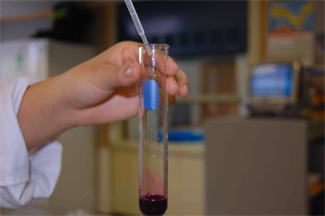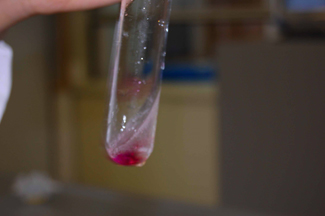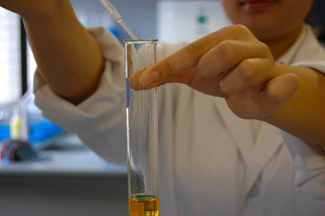
Example 1: Acidified K2Cr2O7 with H2O2
In this reaction, an acidified solution of Potassium DiChromate was reacted with hydrogen peroxide, resulting in the formation of a green-coloured solution. The following half reactions show what is happening in the pictures to the right.
Reduction Half Reaction: Cr2O72- + 14H+ + 6e- --> 2Cr3+ + 7H2O Ešr = +1.23 V
Oxidation Half Reaction: 3 [H2O2 --> 3O2 + 2H+ + 2e-] Ešr = - 0.70 V
Balanced Net Equation: Cr2O72- + 8H+ + 3H2O2 --> 2Cr3+ + 7H2O + 3O2 Eš = +0.53V
The reaction is spontaneous; not only is the theoretical voltage positive, but as you can see from the pictures to the right, there is evidence of a reaction without any external source of energy.
Descriptions of reactants and products:
K2Cr2O7 - liqud, yellow, clear, odourless
H2O2 - liquid, colourless, clear, odourless
Product - liquid, olive green, clear, odourless
Identification of product: From the net equation, the products are Cr3+, H2O and O2. Cr3+ ion gives an olive green colour in aqueous solution. This indicates the presence of Cr3+ ions.
A bit about Chromium: Chromium (III) ion is required in trace amounts for sugar metabolism in humans. Chromium deficiency during total parenteral nutrition has been shown to cause insulin resistance, resulting in diabetes-like symptoms. This can be reversed by taking chromium supplements. Chromium is widely distributed in the food supply, but most foods provide small amounts. Good sources of chromium include meat, whole-grain products, fruits, vegetables, and spices. The popular dietary supplement chromium picolinate is promoted as an aid to body development for athletes. However recently a number of studies have failed to demonstrate an effect of chromium picolinate on either muscle growth or fat loss. In addition, there is concern that chromium picolinate could cause DNA damage and mutation than other forms of chromium (III) ion. Although these results are still a subject of debate, it is better to get chromium from natural food rather than supplements.



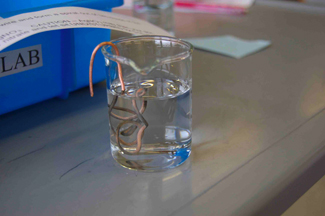
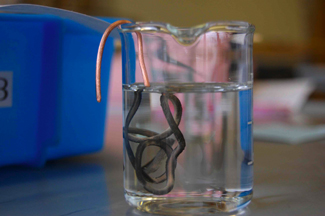
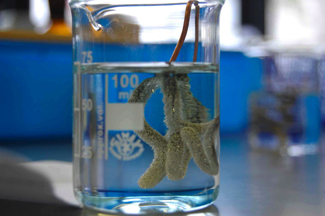
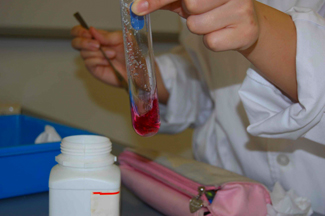
Example 2: Cu with AgNO3
In this reaction, a copper wire was cleaned with sandpaper to remove any oxides on its surface. The wire was then placed into a solution of silver nitrate. Metalic crystals formed on the copper wire after several minutes. The following analysis explains at an atomic level the reason behind this beautiful transformation.
Reduction Half Reaction: 2 [Ag+ + e- --> Ag] Eºr = + 0.80V
Oxidation Half Reaction: Cu --> Cu2+ + 2e- Eºr = - 0.34V
Balanced Net Equation : 2Ag+ + Cu --> 2Ag + Cu2+ Eº = +0.46V
The reaction is spontaneous; the voltage is positive, and the silver crystals that appear in the pictures to the left do so without any energy being added.
Descriptions of reactants and products:
Cu - solid, copper-coloured, lustrous, malleable
AgNO3 - liquid, colourless, clear, odourless
Product - Silvery-coloured lustrous flakes can be seen wrapping around the copper wire. The flakes can be shaken off easily. The solution turned to a clear blue colour.
Identification of product: From the net equation, the final products are Ag and Cu2+. The flakes are silver flakes, indicating the presence of silver. Cu2+ ion gives a blue colour in aqueous solution. The blue solution indicates the presence of Cu2+ ions.
Significant comments: While this reaction can be used to isolate silver from silver nitrate, it is not a common process used to extract silver in real practice. Silver nitrate is the most important compound of silver. It is a very toxic compound if in taken. It is used in the preparation of silver salts for photography because of its light-sensitive characteristic. It is also used in preparation in silver plating, chemical analysis, in inks and hair dyes, and to silver mirrors. In medicine, it is used to treat eye infections and gonorrhea in newborns for its antiseptic properties. In histology, silver nitrate is used for silver staining for demonstrating proteins and nucleic acids. For this reason it is also used to demonstrate proteins in PAGE gels. It is also used as a stain in scanning electron microscopy.
Example 3: Acidified KMnO4 with solid Iron (II) Sulphate
In this reaction, an acidified solution of Potassium Permanganate was reacted with solid Iron (II) Sulphate crystals, resulting in a clear solution. To find out why the crystals disappear and the purple solution changes colour, check out the chemistry below!
Reduction Half Reaction: MnO4- + 8H+ + 5e---> Mn2+ + 4H2O Eºr = + 1.51V
Oxidation Half Reaction: 5[Fe2+ -->Fe3+ + e-] Eºr = - 0.77V
Balanced Net Equation : MnO4- + 8H+ + 5Fe2+ --> 5Fe3+ + Mn2+ + 4H2O
Eº = +0.74V
The reaction is spontaneous; the difference in reduction potentials is positive, and the reaction proceded instantaneously when the reactants were combined.
Descriptions of reactants and products:
FeSO4- solid, green/teal, dull, crystal-like and brittle
KMnO4 - liquid, purple, odorless
Product - Clear solution, no sediment or solids.
Identification of product: From the net equation, the final products are Fe3+ and Mn2+ ions. Both ions are colourless, so the solution supports this predition. In addition, the purple colour disappeared, suggesting that the MnO4,- ions are no longer present.
MnO4-'s applications : The reaction featured above could be desribed alternatively as the oxidataion of Iron by Potassium Permanganate. In fact, the oxidation of substances by Potassium Permanganate is a very common reaction, used often in the treatment of municiple water systems. The reason for this is based in the position of the MnO4- ion on our redox table: it is one of the strongest oxidizing, agents, which means that it can oxidize almost any other substance. This allows treatment centers to oxidize contaminants such as metals (for example, iron!), or organic substances. The Mn2+ ion spontaneously reacts with dissolved O2(g) in the water to form MnO2(s)
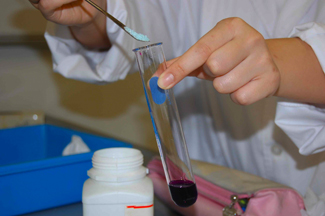

Example 4: Acidified KMnO4 with H2O2
In this reaction, an acidified solution of Potassium Permanganate was reacted with liquid hydrogen peroxide, resulting in a clear solution; during the reaction, bubbles were observed, as can be seen in the second picture. How did it happen? The analysis below explains how the transfer of electrons between the reactants resulted in this clear solution.
Reduction Half Reaction: 2[MnO4- + 8H+ + 5e---> Mn2+ + 4H2O] Eºr = + 1.51V
Oxidation Half Reaction: 5[H2O2 --> O2 + 2H+ + 2e-] Eºr = - 0.70V
Balanced Net Equation : 2MnO4- + 6H+ + 5H2O2 --> 5O2 + 2 Mn2+ + 8H2O
Eº = +0.81V
The reaction is spontaneous; the difference in reduction potentials is positive, and the reaction proceded quickly on its own with the introduction of the hydrogen peroxide reactant.
Descriptions of reactants and products:
H2O2- clear, colourless liquid, odorless
KMnO4 - liquid, purple, odorless
Product - Clear solution, no sediment or solids; during reaction, a large quantity of bubbles were observed.
Identification of product: From the net equation, the final products are water and Mn2+ ions. Both are colourless, so the solution supports this predition. In addition, bubbles were observed, suggesting that the equation is correct in its assumption that oxygen gas was released.
Environmental advantages of H2O2: Hydrogen peroxide's #1 use is in the bleaching of paper; however, it still lags far behind other bleachers, such as Chlorine. In the last couple decades, more and more people have began to demand that the paper they use is 'environmentally friendly'. Since chlorine bleaching leaves highly toxic waste products, many of which end up in rivers where they cause harm to the environment, many people and 'E-friendly corporations' will no longer purchase chlorine treated paper. An alternative that many pulp and paper mills use to bleach the paper is hydrogen peroxide. Environmentally, hydrogen peroxide has significant advantages, because it decomposes to hydrogen and oxygen gas quite quickly in water, thus making it safe to release into rivers; this is attractive to the manufacturer, because they don't have to put in expensive waste treatment plants to please their consumers.
